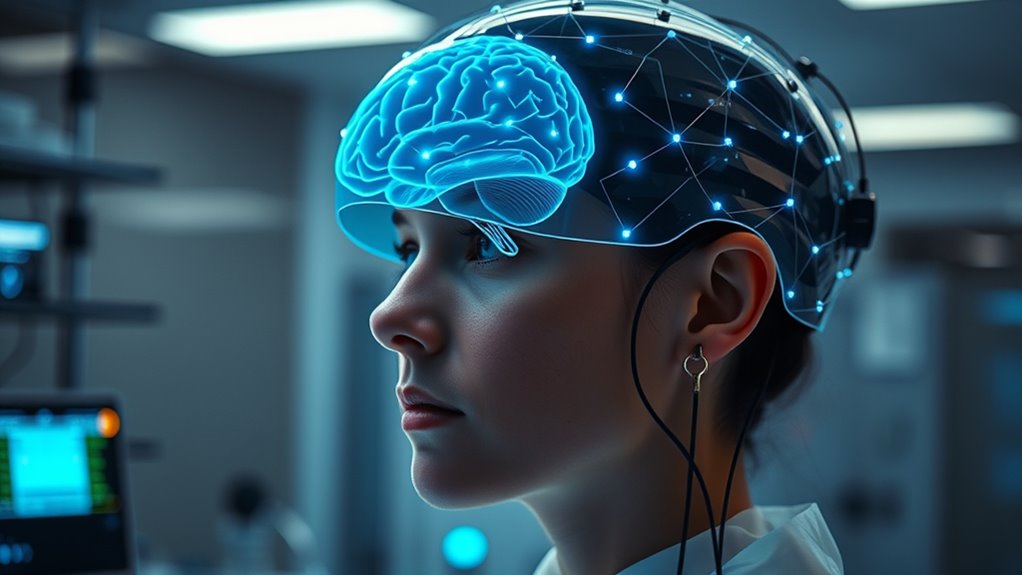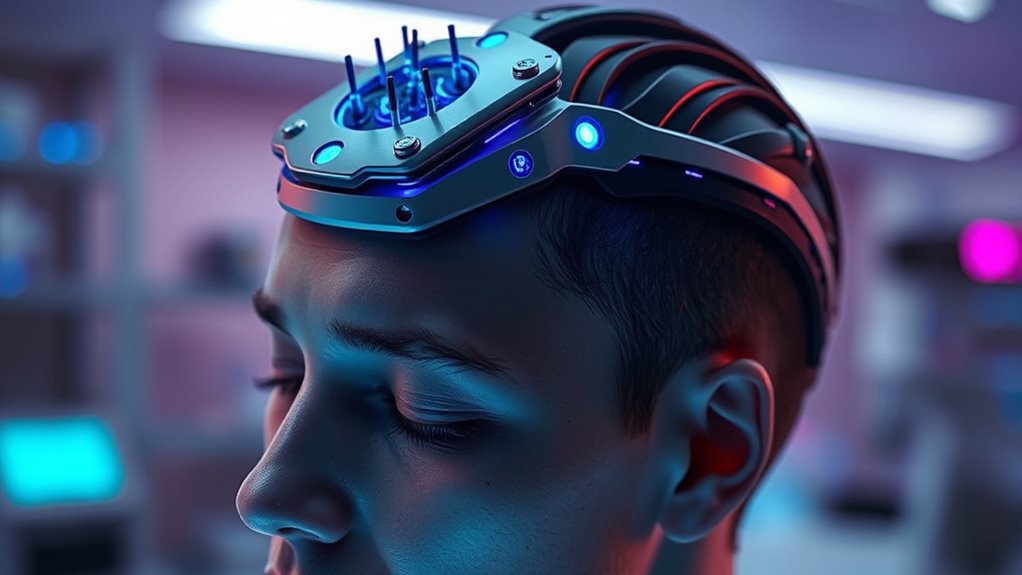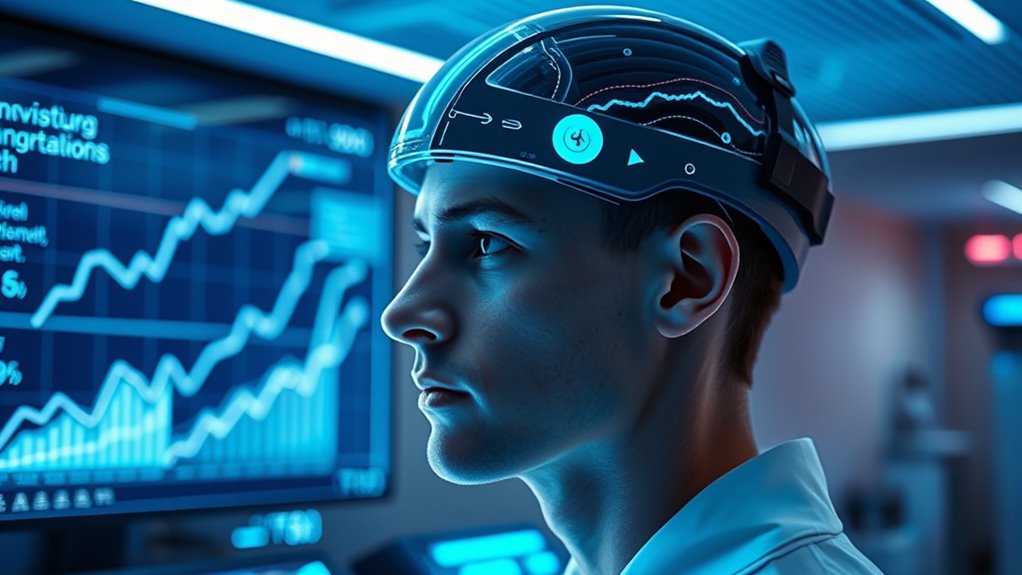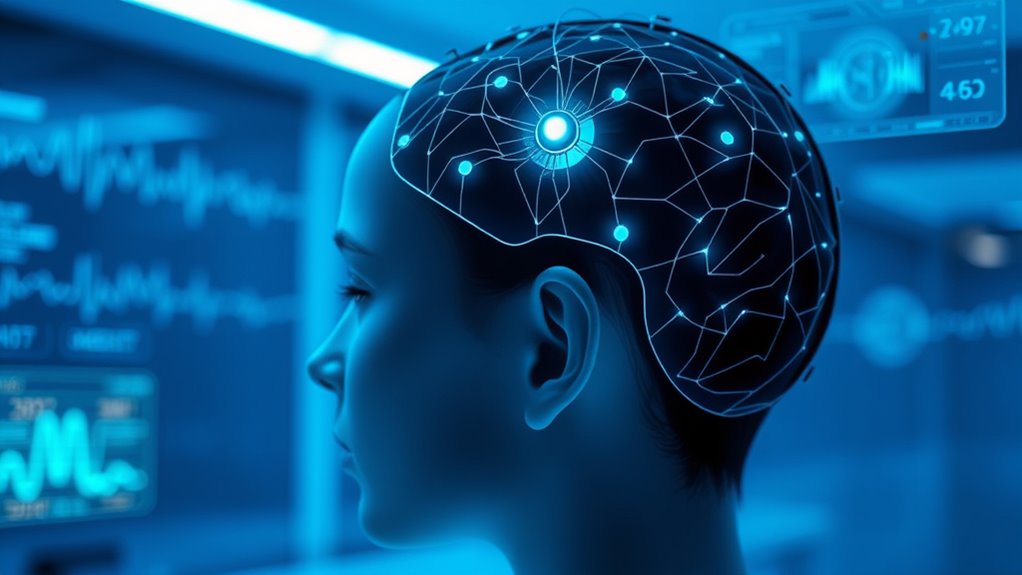Neural interface tech is getting closer to helping you control devices with your thoughts. Advances in hardware, machine learning, and understanding brain plasticity are making systems more accurate and user-friendly. Non-invasive devices are expanding, and market growth shows strong progress. But challenges like signal quality, ethical concerns, and cybersecurity still exist. If you follow what’s happening now, you’ll see how these innovations could soon transform everyday life in ways you might not expect.
Key Takeaways
- Significant progress in both invasive and non-invasive neural interfaces enables more accurate decoding of neural signals.
- Machine learning algorithms are improving real-time interpretation of brain activity for control applications.
- Closed-loop systems with neural feedback are enhancing adaptability and learning in brain-computer interfaces.
- Current developments allow control of prosthetics, communication devices, and immersive experiences through thought.
- Clinical trials and prototypes indicate thought-controlled tech is becoming increasingly practical and close to daily use.
Current State of Neural Interface Technologies

Neural interface technologies are advancing rapidly, driven by innovations in both hardware and software. Open-source projects like OpenBCI are making these devices more accessible by using affordable, consumer-grade electrical components. Researchers are developing neurohybrid interfaces that combine biological and synthetic parts for more complex neural interactions. Both invasive and non-invasive devices are improving, with high-density electrodes and advanced materials enhancing signal accuracy and durability. Wearable technologies are emerging for consumer use, such as brain-controlled typing. Meanwhile, closed-loop systems now provide real-time neural feedback, enabling systems to adapt and learn. The integration of high-density electrodes further enhances the resolution and reliability of neural signals. Additionally, concerns about AI safety vulnerabilities highlight the importance of developing secure neural interfaces to prevent malicious exploitation. As these innovations continue, the gap between experimental devices and practical applications narrows, bringing us closer to widespread, thought-controlled technology. The current landscape is vibrant, with rapid progress across multiple facets of neural interface development, including biocompatible materials that improve device longevity and user comfort. Furthermore, ongoing research into storage and retrieval of neural data aims to improve the efficiency and privacy of neural information handling.
Breakthroughs in Medical and Consumer Applications

Advancements in neural interface technology are now making a profound impact on both medical treatments and consumer products. In medicine, BCIs help stroke survivors regain movement, while paralysis patients control prosthetics using their thoughts. Emerging research shows these interfaces could also slow neurodegenerative diseases like multiple sclerosis and improve mental health. For ALS patients, new BCIs enable speech, restoring communication. On the consumer side, neural interfaces are transforming how you interact with devices—enhanced control, immersive gaming, and assistive technologies are becoming possible. Companies like Neuralink are developing brain interfaces for both medical and everyday use, potentially offering greater independence. These breakthroughs are bringing neural interfaces closer to mainstream adoption, promising to reshape healthcare and how you connect with technology daily. Additionally, ongoing essential oils for health research supports the development of more effective and safe neural interface technologies. Furthermore, addressing concerns related to privacy policies and data security is essential as these devices become more integrated into daily life. As the field advances, understanding the all waterparks available worldwide can inspire innovations in immersive environments and user experiences, both in entertainment and therapy. Moreover, the integration of payment services into neural interfaces could streamline transactions and enhance accessibility for users.
Research into ethical hacking methodologies is also crucial in developing secure neural devices to prevent unauthorized access and protect user data.
Technological Challenges and Recent Innovations

Despite remarkable progress, neural interface technology still faces significant hurdles that limit its widespread adoption. Decoding complex neural signals remains a major challenge, making precise device control difficult. Non-invasive methods struggle with low spatial and temporal resolution, resulting in poor signal quality and high noise levels. Invasive interfaces carry risks like scar tissue formation and surgical complications. Ethical and privacy concerns also loom large, as neural data is highly sensitive. Integrating brain-computer interfaces with the Internet of Things presents additional technical difficulties. Recent innovations are pushing boundaries—open-source hardware like OpenBCI offers affordable alternatives, while advancements in neurohybrid synapses and neuroadaptive tech improve interaction. These breakthroughs pave the way for safer, more effective BCIs, though hurdles still need overcoming for broader use. Additionally, improving the stability of neural signals remains critical for long-term device performance and user reliability. As research progresses, addressing data privacy concerns will be essential to build user trust and ensure ethical deployment. Furthermore, ongoing research into biocompatible materials aims to reduce adverse tissue reactions and improve device longevity. Innovation in signal decoding algorithms is also vital to enhance the accuracy and responsiveness of neural interfaces. Moreover, enhancing the robustness of neural signal transmission can contribute significantly to device stability and user experience.
Market Trends and Industry Growth Projections

The market for brain-computer interfaces (BCIs) is experiencing rapid growth, driven by technological innovations, increasing applications, and rising demand across industries. Globally, the BCI market is projected to expand from USD 3.21 billion in 2025 to USD 12.87 billion by 2034, with a CAGR of 16.7%. In the U.S., the market valued at USD 617.6 million in 2025 is expected to reach about USD 2.7 billion by 2034, growing at 17.9%. Key drivers include rising neurodegenerative disorder cases, advancements in neuroscience, and the gaming industry’s adoption. Non-invasive BCIs grow faster at 9.35%, while invasive types expand slowly at 1.49%. Overall, industry collaborations, increased funding, and evolving applications suggest sustained long-term growth across healthcare, entertainment, and defense sectors.
Ethical and Regulatory Considerations

As neural interfaces become more integrated into daily life, addressing ethical and regulatory considerations is essential to guarantee their responsible use. Privacy concerns are significant, especially the risk of “brainjacking” or unauthorized access to thoughts. These technologies could impact personal autonomy by potentially controlling thoughts or actions. Ethical issues also include ensuring fair access and protecting human rights and dignity. Informed consent must be clear and meaningful. Regulatory frameworks are indispensable to address these concerns, focusing on safeguarding neurodata, establishing cybersecurity standards, and promoting privacy-enhancing technologies. International cooperation is crucial for consistent standards. Devices should offer granular user controls, encrypt data, and allow opt-out options. Regular security audits and legal clarity around liability and data misuse are necessary to build public trust and ensure safe deployment. Additionally, understanding the state tax implications for IRA withdrawals can inform how individuals plan their finances during the adoption of new technologies or life changes. Furthermore, developing robust cybersecurity protocols is vital to prevent breaches and unauthorized access to neural data, ensuring user safety and trust. Incorporating insights from news and technological advancements can help shape comprehensive policies and foster innovation responsibly, while ongoing research into the regulatory landscape remains essential for adapting to rapidly evolving neural interface technologies. It is also important to consider the potential for discrimination or bias in neural data interpretation, which could affect social equity.
Advances in Signal Processing and Machine Learning

Recent breakthroughs in neural signal processing and machine learning are transforming the capabilities of brain-computer interfaces. High-density, miniaturized implants now enable long-lasting, large-scale recordings with better spatiotemporal resolution. Wireless transmission reduces artifacts and boosts real-time signal fidelity, while multimodal sensing combines electrical and optical data for richer neural insights. Advanced preprocessing pipelines, including AI-driven artifact rejection, improve data quality by addressing noise and nonstationarities. Machine learning models like deep neural networks, LSTMs, and CNNs automatically extract features, improving decoding accuracy and efficiency. These algorithms adapt continuously to individual neural patterns, making BCIs more robust. With optimized algorithms, edge computing, and parallel processing, real-time responses in prosthetics and communication devices become increasingly reliable, paving the way for more seamless, thought-controlled interfaces. Additionally, incorporating expert voice actors in the development and testing phases can enhance user experience and clarity in BCI communication systems. Furthermore, ongoing research into biomarker detection can enable BCIs to better interpret complex neural signals, facilitating more intuitive control mechanisms. Moreover, advances in signal processing techniques help address the challenges posed by nonstationary neural data, further improving system robustness. For example, the integration of neural plasticity insights can lead to adaptive interfaces that evolve with the user’s neural changes over time. Additionally, understanding Kia Tuning options can inspire more intuitive and adaptable control schemes for neural devices, enhancing user interaction.
The Role of Neural Plasticity and Adaptive Systems

Neural plasticity plays a crucial role in how brain-computer interfaces (BCIs) enable effective communication between your brain and external devices. It allows your brain to reorganize neural connections, making it possible to learn new control strategies and adapt to BCI use. Adaptive systems use feedback, like visual cues, to induce lasting neural changes, improving control and dexterity. This process mirrors natural skill acquisition, where the brain adjusts through sensorimotor integration. Even in adulthood, plasticity remains significant, supporting recovery from injuries and neurological disorders. BCIs leverage this capacity by creating artificial pathways that promote neural reorganization. While challenges exist, ongoing research aims to optimize these adaptive mechanisms, paving the way for more effective, long-term thought-controlled technologies.
Future Possibilities in Thought-Controlled Devices

The future of thought-controlled devices holds exciting possibilities that could transform how humans interact with technology. You might soon control prosthetic limbs, robotic arms, or even wearable devices simply by thinking, restoring independence and mobility for many. Advances in neural interfaces could enable precise, real-time communication between your brain and machines, enhancing everyday tasks, gaming, and education. Non-invasive BCIs are improving safety and accessibility, making these technologies more practical for widespread use. Future research aims to harness neuroplasticity and refine signal processing, increasing accuracy and responsiveness. As these devices evolve, they could reduce the care burden for families and caregivers, opening new frontiers in healthcare, rehabilitation, and personal empowerment. The potential to merge human cognition with technology is closer than ever. Expert advice suggests that ongoing developments in neural engineering are key to overcoming current limitations and ensuring safe integration. Additionally, ongoing material advancements are crucial for developing more durable and biocompatible neural interface components.
Societal Impacts and the Path Forward

As neural interface technologies become more integrated into society, addressing their societal impacts and the path forward is essential. You need to contemplate how these advances will improve healthcare through better treatments and rehab, but also how high costs might deepen societal divides. Ethical questions about consent and patient rights demand attention, especially as access could widen inequality. Establishing strong regulatory frameworks is critical to ensure safety and fairness. Legally, agencies like the FDA are cautious, and privacy laws must evolve to protect neural data. Socially, these technologies challenge notions of autonomy and identity, raising risks of discrimination. Moving forward, collaboration across disciplines, public education, and clear regulations are necessary to maximize benefits while minimizing risks, ensuring neural interfaces serve everyone equitably.
Frequently Asked Questions
How Safe Are Long-Term Invasive Neural Implants for Users?
You might wonder about the safety of long-term invasive neural implants, and it’s complex. While some devices, like the Stentrode, show no serious adverse events over a year, risks like infections, tissue reactions, and device migration remain. Advances in biocompatible materials and monitoring help improve safety, but long-term effects are still under study. Regular check-ups and careful surgical procedures are essential to minimize potential harms.
What Are the Main Ethical Concerns Surrounding Thought-Controlled Technology?
Imagine your thoughts as a private garden, suddenly open to others’ eyes. The main ethical concerns with thought-controlled tech revolve around protecting your mental privacy from invasive access, preventing mind reading, and avoiding misuse like hacking or coercion. You must also consider fairness; ensuring everyone has equal access, and safeguarding your sense of identity from being altered or diminished. Ethical safeguards are essential to preserve your autonomy and mental integrity.
When Will Commercial Thought-Controlled Devices Become Widely Available?
You might wonder when you’ll access thought-controlled devices. Given current trends, widespread availability could still take several years. Advances in technology, safety trials, and market acceptance are key factors. Companies like Kernel aim for mass adoption by 2033, but real-world use depends on regulatory approvals and consumer trust. So, while progress is steady, don’t expect these devices in every home just yet.
How Will Neural Interfaces Impact Privacy and Data Security?
You should know that over 90% of neural data is sensitive, revealing thoughts and emotions. Neural interfaces could threaten your privacy by collecting and integrating this data with personal info, making detailed profiles. Hackers might access or manipulate your thoughts, risking your autonomy. Without strong security and clear regulations, your mental privacy could be compromised, leading to misuse, coercion, or discrimination—it’s a future you need to prepare for now.
Can Non-Invasive Methods Match Invasive Devices in Accuracy and Speed?
You might wonder if non-invasive methods can match invasive devices in accuracy and speed. While non-invasive BCIs have improved through advanced algorithms, they still face fundamental biophysical limits. The signals they record are weaker and more indirect, leading to lower precision and slower responses compared to invasive systems. Right now, they’re better suited for simple tasks, but achieving the high fidelity and rapid control of invasive devices remains a significant challenge.
Conclusion
As you stand on the brink of a new era, neural interfaces become the bridge connecting mind and machine, symbolizing human ingenuity and our desire to transcend limits. With each breakthrough, you’re witnessing a dawn where thoughts flow seamlessly into technology, transforming lives and societies. The path ahead is filled with promise and responsibility, urging you to navigate with ethical clarity. Together, you’ll shape a future where the mind’s potential becomes an open horizon.









